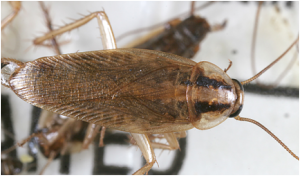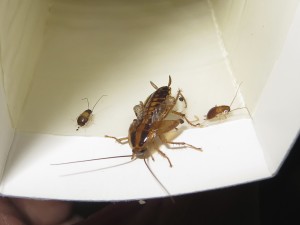German cockroaches are one of the most common insect pests found in urban areas throughout the world, and are the number one cockroach pest species worldwide. They are well-adapted to human environments, even enjoying similar humidity and temperature levels as we do. IPM can be used to exclude and eliminate this pest from our homes, schools, restaurants, ships, and greenhouses.

German cockroach Photo: Gary Alpert
Did you know…?
- By the Numbers: Roughly 3,500 species of cockroach are identified worldwide, with 70 of those species reported from the United States.
- What’s in a Name? Despite its name, the German cockroach, Blattella germanica, probably originated in Africa. In the 375 years since its original description as a species, it has had 23 different scientific names.
- Codependents: German cockroaches depend on humans for their survival. There are no known populations of this species that exist in the wild!
- Ancient Animals: Scientists have found cockroach fossils that date as far back as 300 million years, making cockroaches about 300 times older than humans. The largest fossil, from Ohio, measures nearly 3.5 inches long!
Sticky traps can help you identify both what species of cockroach you have and where their populations are highest.
Integrated pest management of cockroaches not only relies on the proper identification of German cockroaches, but also identifying their hiding areas, which tend to be in areas with high moisture and easy access to food (think: under the kitchen sink or refrigerator). Baiting and trapping can then be used most efficiently. And, as usual, good housekeeping and sanitation will go a long way to reduce both food and areas where cockroaches hide. For more information, see The German Cockroach: America’s #1 Cockroach Pest. For information on other species of cockroaches, click here.
